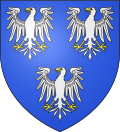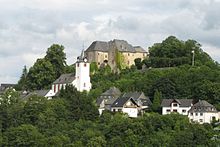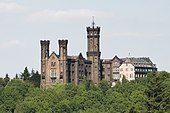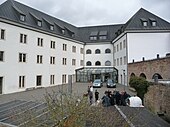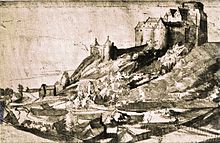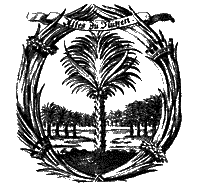
The Fruitbearing Society was a German literary society founded in 1617 in Weimar by German scholars and nobility. Its aim was to standardize vernacular German and promote it as both a scholarly and literary language, after the pattern of the Accademia della Crusca in Florence and similar groups already thriving in Italy, followed in later years also in France (1635) and Britain.
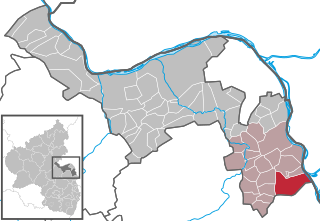
Guntersblum is an Ortsgemeinde– a municipality belonging to a Verbandsgemeinde, a kind of collective municipality – in the Frankfurt/Rhine-Main Metropolitan Region in the Mainz-Bingen district in Rhineland-Palatinate, Germany.
Moritz Hermann of Limburg,, count of Limburg Stirum was the second reigning count of the branch Limburg-Styrum-Styrum.
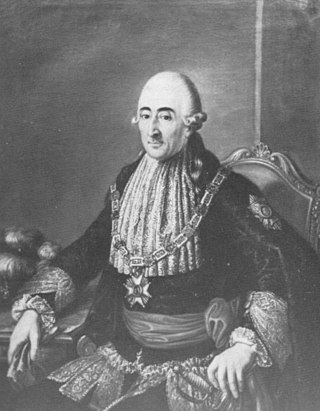
Carl Friedrich Wilhelm, Prince of Leiningen was a Prince of the Holy Roman Empire and the first ruler of the Principality of Leiningen.

Emich Carl, Prince of Leiningen was the reigning Fürst of the Principality of Leiningen. He is an ancestor of various European royals, including Carl XVI Gustaf of Sweden, Felipe VI of Spain, and Constantine II of Greece. After his death, his widow, Princess Victoria of Saxe-Coburg-Saalfeld, married a son of George III of the United Kingdom and became the mother of Victoria, Queen of the United Kingdom.

The title of Prince of Leiningen was created by the Holy Roman Emperor Joseph II, who elevated Carl Friedrich Wilhelm, Count of Leiningen-Dagsburg-Hardenburg to the rank of Reichsfürst on 3 July 1779. Together with all other titles of nobility in Germany, it was abolished with the 1919 Weimar Constitution.

Karl, Prince of Leiningen, KG was the third Prince of Leiningen and maternal half-brother of Queen Victoria. Leiningen served as a Bavarian lieutenant general, before he briefly played an important role in German politics as the first Prime Minister of the Provisorische Zentralgewalt government formed by the Frankfurt Parliament in 1848.
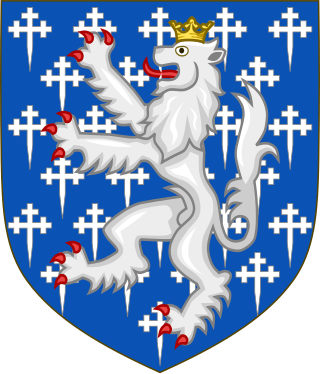
Simon III of Sarrebrück, Simon III von Saarbrücken (Saarbrücken-Leiningen) was the Count of Saarbrücken (de) from 1207 until his death, about 1240.

Neuleiningen Castle is a ruin on the eastern edge of the Palatinate Forest in the state of Rhineland-Palatinate in Germany in the municipality of Neuleiningen in the Bad Dürkheim district. It was built in 1238-41 by Count Frederick III of Leiningen. The French destroyed it in 1690 and it has lain in ruins since that time.

Károly Leiningen-Westerburg was a German honvéd general in the Hungarian Army, and a member of the German House of Leiningen. He was executed for his part in the Hungarian Revolution of 1848, and is considered one of the 13 Martyrs of Arad.

Count Christian Karl Reinhard of Leiningen-Dagsburg-Falkenburg was a German nobleman.

The County of Leiningen consists on a group of counties, which were ruled by the Leiningen family.
Johann Karl August, Count of Leiningen-Dagsburg-Falkenburg was a German nobleman. By descent, he was Count of Leiningen and Dagsburg, by heritage, he was Lord of Broich and Bürgel.

Frederick I of Hesse-Homburg, was the first Landgrave of Hesse-Homburg and founder of the eponymous family line.

Count John of Nassau-Idstein was Count of Nassau and Protestant Regent of Idstein.
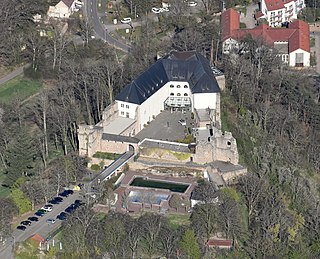
Altleiningen is a castle in the Palatinate Forest in Germany. It lies in the parish of Altleiningen in the county of Bad Dürkheim in the German state of Rhineland-Palatinate.
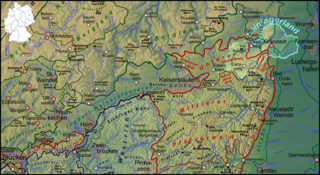
The Leiningerland is an historic landscape in the Palatinate region in the German federal state of Rhineland-Palatinate. It is named after an aristocratic family that used to be the most important in the region, the House of Leiningen.

The Barony of Westerburg, a small principality around the present day town of Westerburg in the Westerwald mountains of Germany, is first recorded in 1209. The eponymous castle, which had probably been built earlier than when it was mentioned for the first time in 1192, was the family seat of the lords of Westerburg, a branch of the lords of Runkel.
